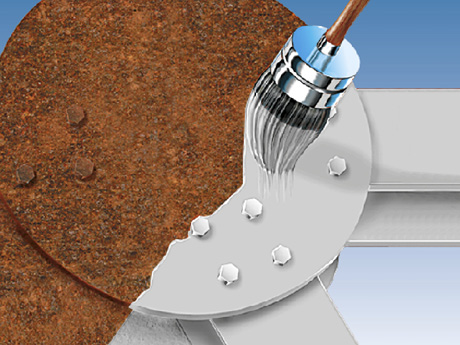Applying anti-corrosive coatings should be easy. For example, we shouldn’t apply them in adverse conditions. The temperature should be no higher than 40 degrees C and no lower than 5 degrees C. It is also a bad idea to apply coating in windy condition or when metal surfaces are wet due to condensation, fog, ice, snow and rain. In this case, we should apply coating when the surface temperature of the metal is higher than the dew point. We should mix each tin of paint with stirrer to disperse coagulated paints. Some coatings are sold as two-pack items, one the base and another is the hardener. They will react chemically and cured. It is important to mix the hardener and the base in the correct ratio. It is essential to use thinner when needed and each product is compatible only with the right thinner.
The amount of thinner we use shouldn’t be more than 5 percent than the paint itself. Excessive use of thinner could cause the coating to sag and this will affect the thickness of the paint. These two-pack items have their usable life after being mixed. In this case, we shouldn’t let the paint stays unused after being mixed. It should be noted that the time interval could be affected by the temperature. Because mixed solutions will expire faster, we shouldn’t mix more than we need. Expired coating is a waste of money and if we use it, it is possible that it will block up the airless spray system. When using the spray, we should check the output pressure and the appropriate tip size. The spray gun should be held no more than 50 cm from the surface or no closer than 25 cm. It should be pointed 90 degrees from the surface and we should pass it on the surface with equal speed. To ensure even film thickness, we may need to overlap previous passes.
We should release the trigger at the end of a pass and for even film thickness, cross hatching is recommended. Paint should be applied at proper wet film thickness, so we need to check the product data. It should be noted that the wet and dry film thickness is different. The wet film could shrink between 50 percent and 70 percent. If necessary, we could use banana gauge or electronic gauge to check the dry film thickness. We could use comb or wheel gauge to check wet film thickness. It is important to consider paint losses. We may lose paint due to windy conditions, expired mixed paint, spillage and over spray. Some paint could also be left unused inside the container of the spraying equipment. There are some coating defects that we need to consider. Due to improper mixing ratio, the drying process can be incomplete or slower.
Improper drying could happen when the coating or paint isn’t mixed properly before application. As an example, we may add too little dying additives. Two pack products should be mixed in proper ratio. For remedy, we should leave the coating for 48 hours until it dries properly and consider whether we need to reapply the coating. If coating is still tacky or soft, we may need to crape it using tool and then sand it until we reach the base substrate.

